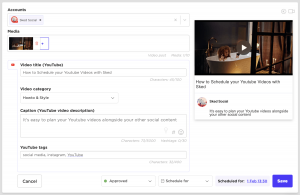— July 9, 2019
Leading a high-impact team is the true test of leadership. Leaders create great teams by optimizing each member’s performance and making the most of the team’s overall potential. Most importantly, great leaders step up to the tough task of managing misfit employees.
It’s a given: At one time or another, nearly every team has an employee who doesn’t fit in. But accurately assessing each person’s potential and determining when it makes sense to invest the effort is an important skill for any leader. If the potential is there, a leader can help someone become a good, purpose-fit member of the team. This will increase camaraderie, accelerate innovation, and earn the leader respect.
FOLLOW THE PASSION
One of the main indicators of a misfit employee is lack of passion. When someone isn’t passionate about the need the organization fulfills, the clients it’s serving, or the vision for how the organization could impact the market, it’s a red flag.
People express passion in different ways, though. The picture of passion isn’t always the extroverted cheerleader who comes to work every day with a positive, can-do attitude. That’s just not everybody. Some of the greatest effort comes from people who are pissed off about what they believe should be done. People might display that passion differently — by fighting to do what’s right for the customer or the organization, for example. They might be driven by conviction to fix problems and accomplish small steps toward a greater vision.
The problem with misfit employees, however, is that they might not possess any sense of passion or drive when it comes to serving the client or impacting the market. There’s no ambition to fix a problem or innovate. Many times, the employee is just collecting a paycheck. In other cases, he or she is damaging the team’s chemistry either by not producing or through confrontational behavior. Leaders, therefore, should keep an eye out for confrontation as a sign of discontent.
SIGNS OF CONFRONTATION
Just like passion can be displayed differently, though, not all confrontation is created equal. Confrontation for confrontation’s sake is unhealthy. It’s frequently self-serving and disrespectful, rather than aimed at achieving a better result. Healthy confrontation focused on a clearly defined problem and finding the right solution is good for a team. So leaders need to determine: Is someone fighting for something or fighting against the team?
Discerning the difference between healthy and unhealthy confrontation isn’t always easy. Take, for example, a clash in leadership in one AEC firm. The business development leader was always arguing with the executive team. The COO, in particular, felt there was constant conflict. As a result, the head of business development was removed from the executive team. That was a mistake.
It turns out that the company was not fully serving the needs of its clients, which is what the business development leader was fighting for. The executive team was OK with that, but the business development leader was not. In this case, the driver behind the conflict was about making the business better. The real problem was the COO, who simply didn’t want to be challenged and could not see the need from the client’s perspective.
Leaders need to apply logic rather than emotion to determine whether a confrontation is constructive or detrimental. In many cases, when the person driving conflict is fighting to arrive at a better solution, that’s demonstrating passion. The confrontation is likely worth it. It might be uncomfortable, but it’s still good for the team.
ADDRESSING THE MISFITS
Misfits can be chronic nonproducers or problem causers whom everyone knows about, but (for a variety of reasons) no one does anything about. Sometimes it’s about managers avoiding conflict and sticking with the status quo, even if it’s holding the team back. Other times, it’s about not wanting to hurt a good person.
Even the most intelligent, kind, high-integrity person can be a misfit in a given scenario. While such situations are painful to address, leaders need to do what’s right for the team, as well as what’s right for the individual. Every person has a role in the workplace. It’s the leader’s responsibility to help each person find his or her purpose, and sometimes that means finding a different role — or employer.
It can be tough when the misfit issue is more about social or cultural aspects of the team. Leaders don’t want to cultivate homogeneity for the sake of avoiding confrontation. Differences can drive camaraderie. For example, at one 40-person mechanical engineering firm, 36 of those individuals are self-described nerds. The remaining employees don’t have the same nerd mentality, but they’re extroverted and highly social, so they’re able to fit in. Within the team, there’s an authentic appreciation for the uniqueness of each person and the value different people bring to the team.
MISFITS, MANAGED
Managing teams is part art and part science. As leaders strive to build high-performing teams, a few common obstacles get in the way.
Often, there’s a lack of clarity on the attributes of a successful team member beyond experience and expertise. Managers and executives need to map out and align on the organization’s purpose, vision, and guiding principles. By doing so, it becomes easier to define the qualities that team members need. It also reinforces how to hire new team members, what to hold people accountable for, and when to fire someone.
After clarity of purpose, leaders need to be equipped with the tools to recognize candidates who are good fits. Prescreening and interviewing tools are essential for understanding personal motivations and how people navigate different situations. Personality profiling tools can be a good addition to the toolbox by helping managers get comfortable digging a little deeper to understand who a candidate is beyond simply what he or she says.
Most of all, leaders have to prioritize doing the upfront work. The overall health and chemistry of the team must be as important as achieving business objectives and meeting project deliverables.
TRIAL, TRAIN, TRADE
After identifying an employee who’s not fitting in well, a leader’s real work begins. Take these three steps to further evaluate the employee’s abilities and correct the issue.
1. TRIAL: Provide a 90-day trial period.
Getting a complete understanding of what’s preventing someone from contributing to the team is key. Establishing a 90-day trial period allows time to uncover whether it’s a lack of training or the employee’s choice.
Here’s an example: A midsized engineering firm identified a potential issue with an executive who was responsible for managing 75% of the company’s workforce. On paper, the executive gained leadership skills through military service that should be transferrable to the construction industry. In practice, he was the source of unhealthy conflict within the organization. By implementing a trial period, the company uncovered that he had some personal conflicts about transitioning his skills from the military to the private sector.
2. TRAIN: Deliver targeted training.
Once the issue is identified, determine whether it can be addressed through training. Invest effort in education and support aimed at helping the employee overcome the obstacles preventing him or her from contributing. But set clear parameters and time frames for improvement.
In the example of the former military man leading a team at the engineering firm, the company provided training to help him translate his knowledge and skills to better fit the organization and his team. As the training continued, his employee engagement scores went up by 18%.
3. TRADE: Take action.
Good leaders know when to say when. If an employee’s behaviors don’t change after the trial period and appropriate training, don’t perpetuate the distraction. Trade the employee for a new candidate who is a better fit as quickly as possible. If there’s another option for the misfit employee internally — both in terms of skills and passion — that’s great. But if there’s not, it’s important to take decisive action and let the person go.
People are not inspired in negative environments. Misfit employees can put a team into constant defensive or survival mode. In contrast, a leader who identifies an issue and proactively works with the employee to resolve it establishes a positive team culture based on camaraderie, innovation, and respect.
If you are a leader in the AEC community, take the free P10 Evaluation to benchmark your company’s success and learn about how to improve in 10 practice areas.
Business & Finance Articles on Business 2 Community
(66)







